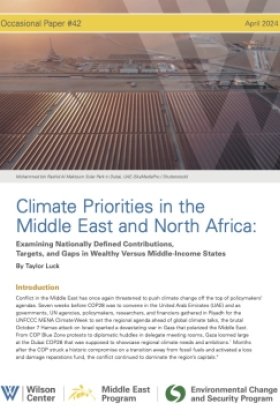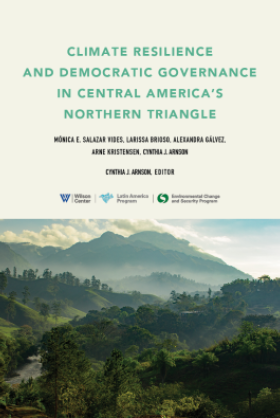Water Abundance in Canada and the United States: Myth or Reality?
For the launch of the 10th One Issue, Two Voices series, authors David Brooks and Tracy Mehan discuss the obstacles and solutions to achieving sustainable water futures in Canada and the United States.
Overview
Canada is a laggard when it comes to water policy, argued David Brooks of Friends of the Earth Canada at a conference hosted by the Canada Institute in collaboration with the Wilson Center's Environmental Change and Security Program on January 26, 2009. Brooks was joined on the panel by coauthor Tracy Mehan of the Cadmus Group for the publication launch of the Canada Institute's tenth One Issue, Two Voices series, which assessed the obstacles and solutions to achieving sustainable water futures in Canada and the United States. Benjamin Grumbles, former assistant administrator of the Office of Water in the U.S. Environmental Protection Agency, served as moderator.
Separating Facts from Myths
In 1987, noted Brooks, the Canadian parliament passed some of most progressive legislation on water management in the world. Unfortunately, much of the legislation was never implemented and that which was implemented was never enforced. Brooks maintained that the Canadian government's failure to implement the legislation can be partially explained by the perception held by many Canadian politicians that Canada has an abundance of fresh water and therefore does not need regulations to manage its supply. Politicians and the media, argued Brooks, often cite that Canada has 20 percent of the world's fresh water, when the correct figure is in fact closer to 7 percent. Furthermore, much of the fresh water in Canada is located far from the country's population centers and is difficult to access.
Brooks stressed that Canada must take immediate action to ensure the effective management of its water resources. To this end, Canada must first work toward restoring its research and monitoring capabilities, noting that the federal government has not only largely ignored those areas, but actually cut the research and monitoring budgets for water in the 1980s and 1990s. These cuts have made it extremely difficult for the Canadian government to draft effective legislation, he explained, because officials have no idea what is happening to the country's water resources. Poor oversight and a lack of effective regulations monitoring Canada's water supply have also contributed to numerous cases of tainted water, most notably in Walkerton, Ontario, where seven people died from drinking water that contained a deadly strain of E. coli.
Brooks also criticized the conditions of many First Nations communities throughout Canada where people live with chronic water problems and boil-water advisories. Solving these problems will require funding from the federal government to develop the institutional infrastructure necessary to train local staff to operate the country's water infrastructure and ensure that water quality standards are upheld.
Brooks also outlined three major issues concerning water that must be addressed bilaterally. The first concerned the precise role of the International Joint Commission (IJC) in settling water disputes between Canada and the United States. Though the IJC is often held as an institutional model for settling transborder issues, Brooks argued that in recent years Canada and the United States have not turned to the IJC to resolve bilateral water issues or develop water policy. He also criticized Canada's cavalier attitude in approving large-scale water diversion projects without paying the necessary attention to their environmental effects. Brooks said that several major Canadian water projects constructed to generate hydroelectricity or provide water for irrigation have drawn substantial criticism from environmentalists because of their limited economic benefits and high environmental damage. Critics also point out that much of the hydropower and agricultural products produced are exported to the United States.
A third bilateral issue in need of discussion is bulk water exports. Although several major Canadian studies have concluded that large profits can be made by the sale of bulk water to other countries, this conclusion, said Brooks, ignores the fact that the infrastructure needed to pump and transport the water would be extremely expensive, not to mention an extraordinarily unpopular idea among the vast majority of Canadians. He added that it is only farmers who would desire more water; however, they are not used to paying high prices for the commodity and would likely hesitate to incur high costs for imported water from Canada.
Assessing Water Management in the United States
North Americans do not fully appreciate the value of water, said Tracy Mehan, noting that in the case of the United States, Americans do not pay the full cost of maintaining its water infrastructure let alone the true value of water's ecological, social, and economic benefits. Americans are also guilty of continuing to subsidize the wasteful use of water for agricultural purposes, filling wetlands, clearing forests, and paving areas that disrupt the natural flow of water. Furthermore, little effort has been put forth to establish a monetary value on water that reflects its varied uses, said Mehan, noting that Americans are charged the same amount for water whether it is used for drinking or filling swimming pools.
However, attitudes toward water are changing in the United States. Brooks cited a recent survey by the U.S. Geological Survey that found that despite a growing U.S. population, water demand has varied less than 3 percent since 1985. Nevertheless, a sustainable water future in the United States will require policymakers to rethink proper water management in a way that emphasizes demand-side management, treats waste water as an asset to be reused and recycled, and manages watersheds in a sustainable manner.
Achieving this, said Brooks, will require a regulatory framework that ensures consumers pay the full cost of water, as well as other restrictions on its use. Establishing the right price for water will be crucial to maintain water infrastructure and encourage water efficiency. However, Brooks said that he is aware that policymakers face an uphill battle in convincing the American public to accept the wisdom of paying for their water as they pay for other utilities. Mehan also said technology will play a part in achieving a sustainable water future and highlighted desalination and water recycling as particularly promising approaches to water reclamation.
Drafted by Ken Crist.
Hosted By

Canada Institute
The mission of the Wilson Center's Canada Institute is to raise the level of knowledge of Canada in the United States, particularly within the Washington, DC policy community. Research projects, initiatives, podcasts, and publications cover contemporary Canada, US-Canadian relations, North American political economy, and Canada's global role as it intersects with US national interests. Read more

Environmental Change and Security Program
The Environmental Change and Security Program (ECSP) explores the connections between environmental change, health, and population dynamics and their links to conflict, human insecurity, and foreign policy. Read more
Thank you for your interest in this event. Please send any feedback or questions to our Events staff.









